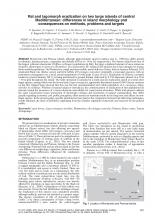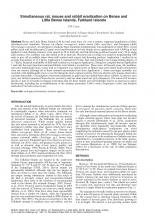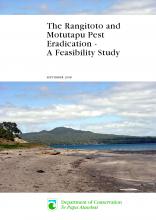The Rangitoto and Motutapu pest eradication - a feasibility study.

BRB
Available Online
Griffiths, Richard.
,
Towns, David.
2008
The eradication of the seven remaining animal pest species remaining on Rangitoto and Motutapu was announced by the Prime Minister and Minister of Conservation in June 2006. With stoats, cats, hedgehogs, rabbits, mice and two species of rats spread across an area of 3842ha, the proposed project is the most challenging and complex island pest eradication the Department of Conservation (DOC) has ever attempted. To better understand the scale and complexity of the project, a feasibility study was undertaken. This study considered the ecological, economic and social context of the project to allow an informed decision to be made on whether or not to commit resources to further eradication planning. This document outlines the findings of the feasibility study and concludes that while a number of contingencies exist within the project, the proposed eradication is not only feasible, but has many significant benefits. No single precedent exists on which this project can be modelled and information from a wide range of sources has been required. Previous eradication and control programmes have been reviewed in conjunction with what is known about the behaviour and biology of the target species. In some cases, where information has not been available and could not be inferred, trials have been undertaken. The document has been reviewed by a number of experts both within New Zealand and overseas including DOCs Island Eradication Advisory Group. Consultation has also been undertaken with all of the islands key stakeholders and communities of interest. Comments from all of these parties have been reflected in the report. Rangitoto is an iconic Scenic Reserve located just 9km from downtown Auckland City. The island is internationally significant both for its ecology and geology and is an extremely popular visitor destination served by regular ferry services. Motutapu, a Recreation Reserve, is connected to and positioned immediately to the east of Rangitoto. The island, currently managed as a pastoral farm, is noted for its extensive archaeological record but retains a diverse range of habitat types and is the focus of a community-led restoration programme. In addressing the question, can it be done? particular attention has been paid to mice, ship rats, hedgehogs and rabbits as eradication of these species on the scale of Rangitoto and Motutapu has never been attempted. Preventing reinvasion on such highly accessible and intensively visited islands is also an enormous undertaking. It is accepted, that of all the target species, mice present the greatest risk of failure. However, while a number of mouse eradications around the world have failed, all ten attempts on islands beyond the swimming range of mice that have followed current Departmental best practice have been successful, providing confidence in the method. Rangitoto and Motutapu are a significant step up from previous operations in terms of scale but are also the logical next step to apply current techniques. Despite the unprecedented elements within the project, it is considered that the key dependencies on which eradication success relies can be met for the species targeted. Preventing reinvasion is perhaps the most important consideration of the feasibility study and the one that will ultimately determine the fate of the project. Achieving an adequate level of protection for the islands hinges heavily on changing the behaviour of all 100,000 visitors that arrive on an annual basis. Without this any investments made in removing pests will be wasted. Bringing these changes about appears possible but is contingent on a number of commitments and actions that must be put in place by both DOC and its key partners. The feasibility study also addresses what the project will take to complete and attempts to identify as many of the planning issues as possible to enable the project to be properly sized. It explores the techniques that must be used, the resources that will be required and the timeframe over which they need to be deployed. While this eradication project is the most challenging and complex to be undertaken by DOC, it also presents a significant opportunity to improve our current understanding of eradication theory and practice. If successful, the project offers outstanding benefits for conservation. The recovery of locally and nationally endangered species, the creation of a stepping stone for wildlife movement between the Hauraki Gulf and the Auckland isthmus, the potential for advocacy and education, and increased recreation and economic opportunities are just some of the likely gains. The study has shown that this project is feasible, but also that there are many significant reasons why it should proceed.




